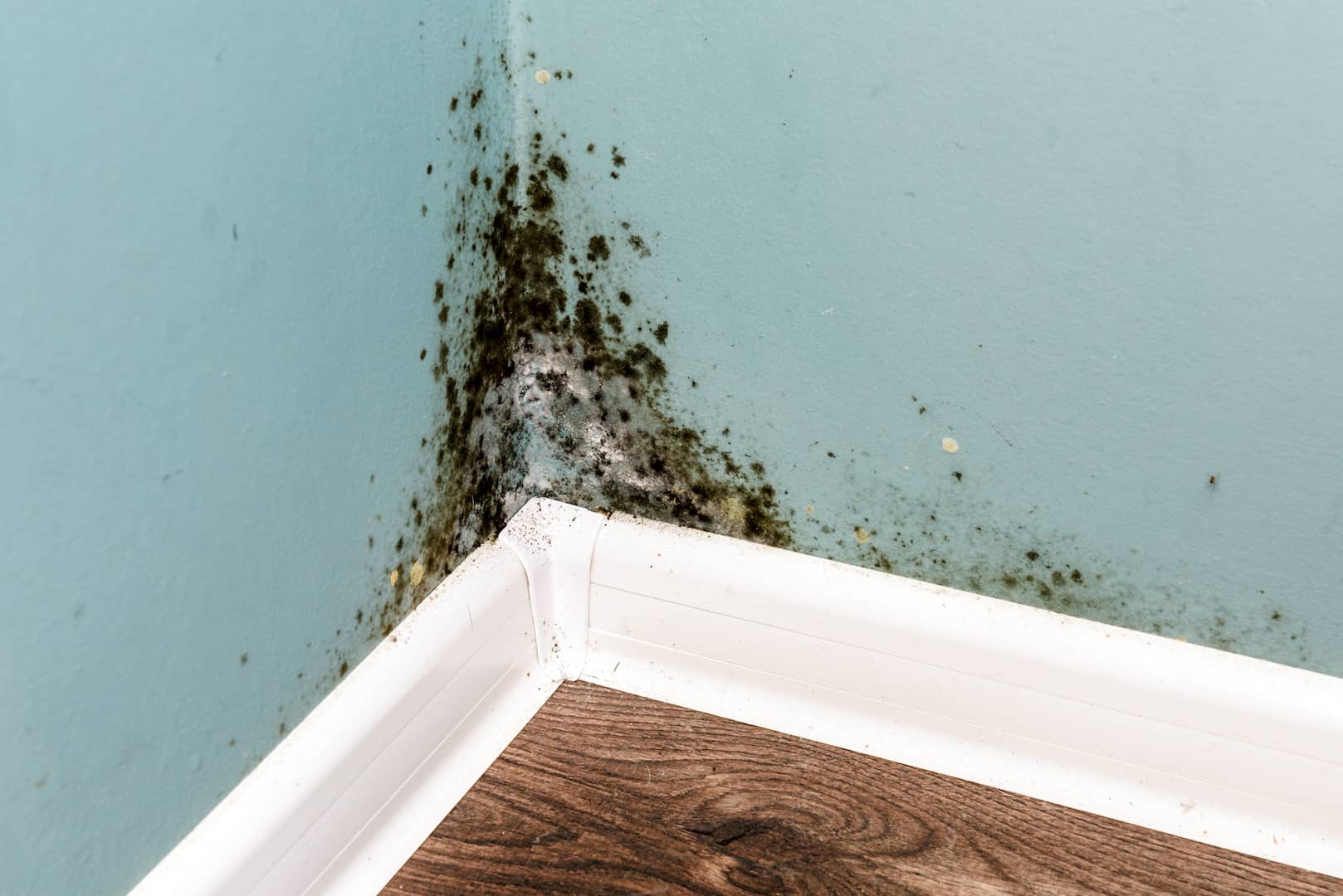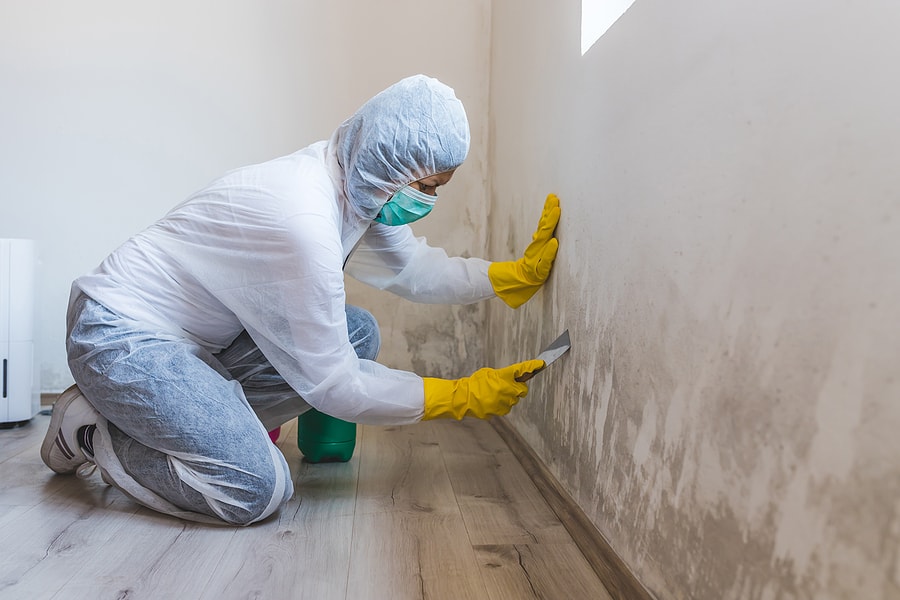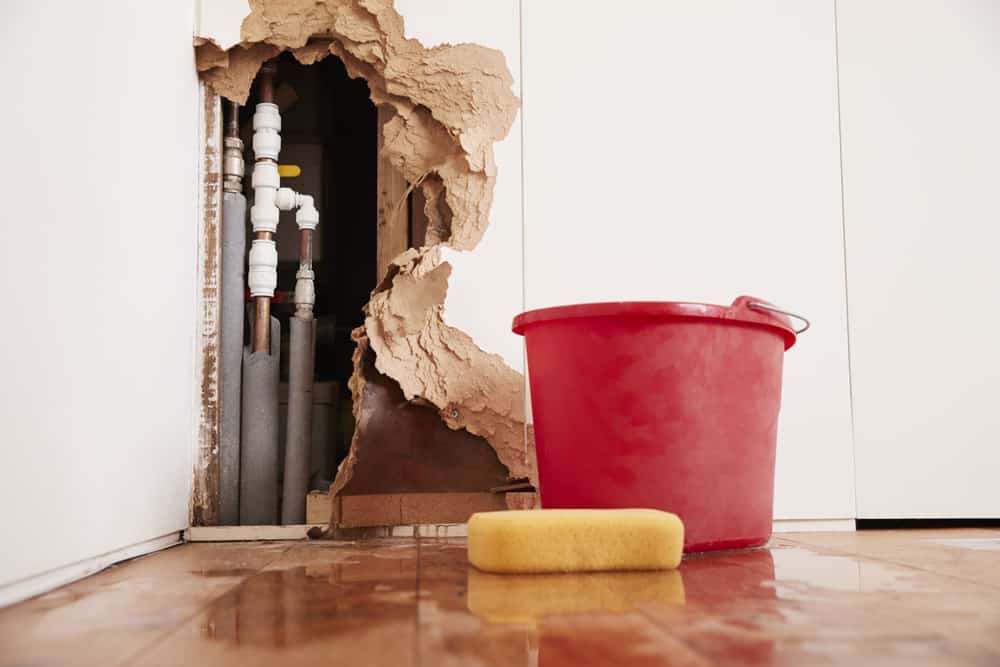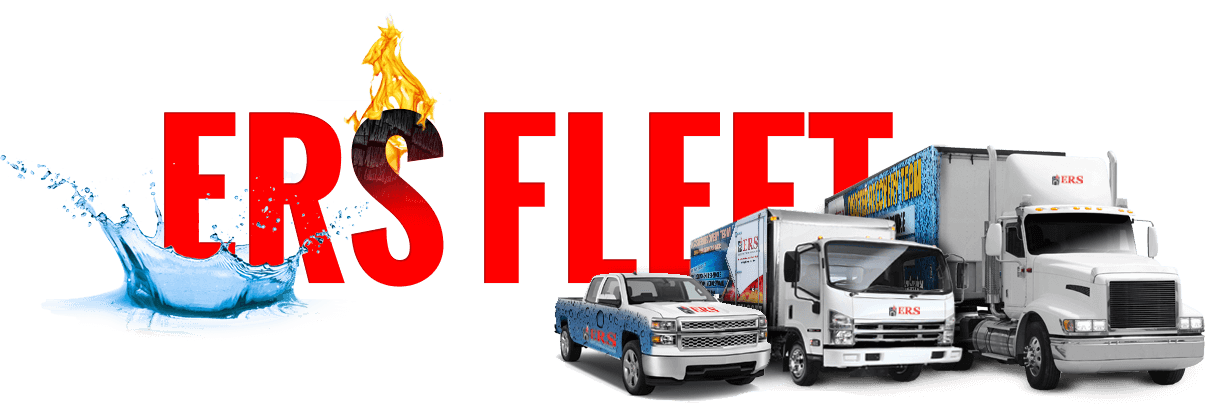Don’t Mess with Mold – Get It Checked!
You find some mold on your wall, and scrub it with some borax and a sponge. All good? No! If you can see the mold, it’s already been growing in your floors and drywall for ages..
Have it checked out – healthy people die from poisonous mold. Contact ERS today.
EXPERT MOLD REMOVAL & REMEDIATION SERVICES IN WISCONSIN
ERS has been restoring homes and businesses for over 33 years. With this experience and our dedication to excellence, we have achieved an A+ rating with the Better Business Bureau.
When you contact ERS, expect us to arrive promptly regardless of the time. Our IICRC-certified mold remediation experts safely eliminate mold and prevent future growth. Call for a free quote!
Contact ERS at 877-422-6379 to remove mold in Wisconsin.
OUR MOLD REMOVAL AND REMEDIATION PROCESS
Mold remediation is crucial to eliminating and preventing mildew in homes and buildings. Our remediation process involves a comprehensive approach to effectively locate, isolate, and remove the disposition.
Our restoration team conducts testing to identify the type and extent of the infestation and mold damage. We then implement appropriate containment measures to prevent further spread. We safely remove the disposition using specialized equipment, ensuring minimal disruption to your property. We also handle odors from the disposition and leave your space smelling fresh.
Additionally, we provide recommendations for moisture control and preventive measures to prevent future mold issues. Trust us for reliable and efficient mold removal and remediation services.
Common Questions about Mold Removal
There is nothing unusual about mildew in the home. It is a critical part of our ecosystem—they help decompose dead organic matter. However, you don’t want a significant buildup of the stuff. It could eat away at the structure of your home and decompose your possessions. Not good.
If your answer is “yes” to any of the following questions, you may have a mildew problem.
- Can you see it? Check spots in your home with lots of moisture, like your kitchen, bathrooms, laundry area, and basement.
- Can you smell it? Does it smell sour or musty in damp areas? Follow your nose—the smell is usually the first indicator.
- Is there evidence of water damage, condensation, or excessive moisture? If structures in your home are wet for over a day, mold will probably grow.
Mold can be hidden. If any area of your home experiences extensive exposure to moisture, the fungus will grow. You may not see or smell it, but it can be there. Check places where water tends to collect and cause problems in your home.
Mold is often found in air ducts of Wisconsin homes and businesses. The changing weather of drastic seasons means your HVAC system is likely producing moisture you can’t see, cultivating the perfect environment for fungus growth. If it grows in your ventilation system, spores are circulated throughout your home, contaminating indoor air quality. Symptoms of mold include allergic reactions (sneezing, runny nose, itchy eyes) and asthma or respiratory issues. Depending on the level of sensitivity, some may even experience a rash or hives.
Clean your air ducts immediately if you suspect disposition or can see it on your vents. Your ventilation system picks up all sorts of particles – including dust, dander, hair, dead skin, and other debris – and then pushes them right back out to be breathed by you, your family, or your employees. If your air ducts are blowing out spores, it’s creating exponential opportunities for mold to grow on other damp or moist surfaces, enlarging your overall problem. Choose ERS for air duct cleaning if it contributes to poor indoor air quality. Our experts will get there within the hour to thoroughly remediate the issue.
Chances are, no. Testing for mold probably won’t tell you anything you don’t already know. Mold testing may be able to document the type of mold, but this isn’t entirely relevant. You want it gone, no matter what kind of mold it is. If your home exhibits the common symptoms of mold growth, it’s probably there. Any time or money spent on testing for it is better spent on getting it remediated.
There are occasions when testing for mold makes sense. A health concern may require a particular kind of mold to be identified. Testing may be required for litigation, most often to document the reduction in mold levels with removal and cleaning. But, for the most part, it isn’t worth it. If you think it’s there, it’s probably there. Contact our mold remediation experts in the Milwaukee area and get it cleaned before it becomes a big problem.
The problem with this question is that “black mold” is a catch-all term covering much ground. Some mold can cause health problems, but not all kinds of black mold. Black mold is not a species or specific kind of mold. Black mold often refers to certain types of molds that can produce toxic compounds called mycotoxins. Whether or not mycotoxin is produced is a matter of where the mold is growing, temperature, pH, humidity, or other factors we don’t yet know.
The short answer—the presence of “black mold” doesn’t necessarily mean it’s dangerous (mycotoxins are not always present).
There isn’t enough information on mycotoxins—how they’re produced or their effect—to make any definite conclusions. We do know mold very rarely causes unique or rare serious health conditions.
Minor problems easily seen and accessible, usually covering an area of 10 square feet or less, can be remediated easily in a few hours and a trip to the hardware store. However, if you suspect the problem is worse than it appears, consider contacting our contractors if any of the following conditions apply to your home.
- If the size of visual contamination takes up half the ceiling, attic, or wall. More than a few isolated areas of mold means you have a significant problem on your hands and need the help of professionals.
- If you smell it but can’t see it. It may be inaccessible, like in a wall cavity or above a suspended ceiling. Leave it to the professionals to go after hidden tough places.
- Floods—if you’ve had standing water in an indoor space for over 24 hours, you need a professional to assess according to established guidelines.
- You have inhabitants who lack a healthy immune system. Special set-ups and procedures may be necessary to make sure you aren’t putting someone at risk.
Contact our professional remediators in Milwaukee if you have any doubts. You can trust us to assess your situation honestly and help you decide whether you need mold removal and remediation services.
Contact Restoration Professionals in the Milwaukee area at 877-422-6379.
Don’t Mess with Mold – Get It Checked!
You find some mold on your wall, and scrub it with some borax and a sponge. All good? No! If you can see the mold, it’s already been growing in your floors and drywall for ages..
Have it checked out – healthy people die from poisonous mold. Contact ERS today.



MOLD REMEDIATION & CLEANING IN WISCONSIN | MOLD DAMAGE RESTORATION SERVICES
RESTORATION COMPANY REMOVING MOLD IN HOMES AND BUSINESSES
ERS provides mold removal services for residential and commercial properties in Wisconsin and Illinois.
After your building undergoes water damage, it is extremely important to have a complete mold inspection.
When mold begins to develop in your home or business, the disposition will produce a dank, musty odor and contaminate parts of your building. Over time, mold spores in the air will create respiratory problems or serious allergic reactions. It’s best to contact ERS mold remediation experts before mold overgrows on your property.
ERS will stop mildew to prevent it from fouling your home or business air.
Our Wisconsin mold removal technicians will arrive quickly to ensure you have clean air to breathe.
Call 877-422-6379 for residential or commercial mold removal and cleanup services in WI and IL.
WHY CHOOSE OUR MOLD REMEDIATION SERVICES IN WI?
- Over 33 years of disaster restoration experience
- 24/7 response to emergencies
- IICRC-certified technicians
- Direct billing to insurance companies
- A+ BBB rating
- Over 200 5-star reviews
- Local expertise in Milwaukee and surrounding areas
COMPREHENSIVE MOLD REMOVAL SERVICES: DAMAGE CLEANUP AND REMEDIATION
Our comprehensive mold removal services are designed to address all aspects of contamination, ensuring the safety and well-being of occupants while restoring the integrity of the affected space.
Our restoration team follows a meticulous process that includes a thorough inspection, containment, removal, disinfection, and preventive measures to prevent future outbreaks.
We use advanced restoration equipment and techniques to detect hidden dispositions, effectively remove them, and restore the affected area to a clean and healthy environment. With our unwavering commitment to quality, safety, and customer satisfaction, you can trust ERS to provide reliable and effective mold removal services tailored to your needs.


Mold Removal and Restoration Service
When the specialists from ERS arrive, we take every step necessary to ensure the disposition is removed and won’t grow back.
Helpful Mold Removal PDF’s
Guide to Mold Remediation
Condensation Guide
Lowest Price Guarantee
How to Save A Real Estate Deal
Sometimes mold grows in hard-to-reach places like wallpaper or behind wood floorboards. Our technicians are extra thorough with inspection, removal, and restoration to ensure you and your family will not suffer health risks from mildew.
Clean-up for Water Damage and Fire Damage
ERS recognizes the critical link between water and fire damage and the potential for mold growth, emphasizing the importance of swift and comprehensive cleanup services to mitigate these risks. Our restoration team is equipped to handle all aspects of water and fire damage cleanup, utilizing proper technology and methods to extract water, dry out affected areas, remove soot and ash, and repair damage to structural elements and personal property. This integrated approach not only restores your property to its pre-disaster condition but also prevents the conditions that lead to mold development. Our fire restoration service also includes smoke damage remediation.


RESTORE YOUR PROPERTY WITH ERS
Time is of the utmost importance. With every minute passing by, more damage is done to your home and valuables. Secondary problems will start setting in – like advanced water damage, water seepage & wicking.
For this reason, ERS is available 24/7. We know disasters don’t accommodate personal schedules. Call us when disaster strikes your home, and we’ll rush over immediately and get to work mitigating the mold damage and restoring your property.
Contact our restoration professionals in Milwaukee at 877-422-6379.
The 4 Most Common Types of Household Mold
 Aspergillus
Aspergillus
This is most commonly found in autumn and winter in the northern hemisphere. The best growth conditions for this fungi vary greatly depending on the species. Aspergillus can be found indoors or outdoors, with some of the more popular places being:
- Water storage tanks
- Food compost
- Fire-proofing materials
- Ventilation and A/C units
Contact ERS at 877-422-6379 to remove mold in Milwaukee and the surrounding areas.
 Stachybotrys Atra
Stachybotrys Atra
Stachybotrys is a fairly slow-growing mold. The presence of this may cause allergic reactions in sensitive individuals.
COLOR VARIATIONS:
- Black
- Orange
- White
- Pink
Stachybotrys, like most molds, flourish in dark, humid areas. No cases of human or animal infection are known to have occurred.

Penicillium
Penicillium is one of the most common fungi known throughout the world. The color of this fungi varies and can be green, blue-green, grey-green, white, yellow, or pinkish. Colonies are often velvety or powdery textures and prefer a moist environment:
- Water-damaged buildings
- Wallpaper
- Wallpaper glue
- Decaying fabrics
- Behind paint
Penicillium often causes allergic and asthmatic reactions in humans.

Cladosporium
Cladosporium produces a black pigment as it grows. The fungus often becomes powdery due to the high levels of conidia.
It’s common for other types to be present when you find Cladosporium in your home.
IDEAL GROWING ENVIRONMENT:
- Over 50% relative humidity
- Textiles
- Wood
- Moist window sills
- Tile grout
CONTACT THE MOLD REMOVAL EXPERTS AT 877-422-6379 TO KEEP YOUR HOME AND BUSINESS FREE OF THE HEALTH RISKS IT CAUSES.
How to Prepare Your Property for Mold Inspection and Remediation
Preparing your property for mold inspection and remediation facilitates a thorough and efficient process. ERS provides the following steps homeowners and business owners can take to prepare their properties for our comprehensive damage restoration services.
1. Document the Affected Areas
Before the mold removal service team arrives, take photographs or videos of all affected areas. This documentation can be valuable for both the remediation process and any insurance claims. Ensure you capture the extent of visible mold and any water damage that may have contributed to the mold growth.
2. Clear Access Paths
Ensure there is a clear path to the affected areas. Move furniture, rugs, and other belongings away from the walls or spaces where the mold has been identified. This not only speeds up the inspection process but also helps prevent further contamination of your belongings during the cleaning services.
3. Protect Unaffected Areas
Try to isolate the affected area as much as possible to prevent the spread of mold spores during the mitigation process. You can use plastic sheeting and tape to seal off doorways or vents connecting to other building parts. However, do not compromise ventilation unless advised by the restoration services team.
4. Address Moisture Sources
Identify and address any immediate moisture sources contributing to the mold problem, such as leaks or condensation. While the mold removal service will handle thorough moisture mitigation, stopping existing leaks can prevent further growth before the team arrives.
5. Inform the Technicians About Health Concerns
If you or anyone in the property has health concerns or allergies related to mold, ensure you communicate this to the damage restoration service company beforehand. This information allows us to take additional precautions and tailor our restoration services to accommodate your health and safety needs.
6. Prepare for Temporary Relocation
Depending on the extent of the mold infestation and the areas needing remediation, you might need to vacate the property temporarily. Arrange for alternative accommodation in advance, especially if sensitive individuals, like children or those with respiratory issues, are present.
7. Secure Pets and Valuables
Ensure pets are moved to a safe location away from the remediation area, and secure any valuables or sensitive items. While a professional mold removal service like ERS takes utmost care during remediation, securing these items can prevent accidental damage or loss.
By preparing your property for mold inspection and remediation, you’re taking proactive steps toward a successful and efficient restoration. ERS is committed to providing high-quality mold remediation and damage restoration services, ensuring your property is restored to a safe and healthy condition. Contact us for comprehensive mold mitigation and restoration services tailored to your needs.
We Also Offer Water Damage Restoration Services
ERS is a leader in mold removal and remediation and specializes in comprehensive water damage restoration services. Water damage, whether from flooding, leaks, or high humidity, can severely impact the structure of your home or business and create an environment conducive to mold growth. Recognizing the urgency of these situations, our team is equipped to address all aspects of water damage, ensuring a prompt, efficient, and thorough restoration process.
Our water damage restoration services encompass everything from initial water extraction and drying out of affected areas to repairing and restoring damaged property. Utilizing state-of-the-art equipment and techniques, our IICRC-certified technicians work diligently to minimize the impact of water damage, prevent the onset of mold growth, and restore the affected area to its pre-damage condition. We understand the complexities of water damage restoration and are committed to providing a seamless, hassle-free experience.
In addition to emergency water extraction services, ERS offers moisture detection, dehumidification, drying, sanitization, and cleaning services to ensure a comprehensive recovery from water damage. Our approach is designed to address both the visible effects of water damage and the underlying moisture issues that could lead to future mold problems. By choosing ERS for your water damage restoration needs, you’re enlisting a company with a proven track record of delivering high-quality services, ensuring your property is safe, clean, and fully restored.
CONTACT ERS FOR MOLD DAMAGE RESTORATION SERVICES IN WI & IL
Act now to protect your residential or commercial property and health! Contact ERS for expert mold damage restoration services in Wisconsin and Illinois. Call 877-422-6379 to schedule your inspection and ensure a mold-free environment today!



